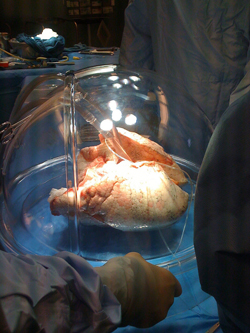A TGH research team has, for the first time, shown in a clinical trial that the Toronto XVIVO System can safely and effectively treat, re-assess and improve the function of high-risk donor lungs so that they can be successfully transplanted into patients. The use of this technique could significantly expand the donor organ pool and improve outcomes after transplantation.
In their pioneering work, a team of researchers led by Dr. Shaf Keshavjee, Surgeon-in-Chief, UHN, showed, in their latest research on this world-first technique, that using high-risk donor lungs which were improved and re-tested in the Toronto XVIVO Lung Perfusion System before transplantation led to results that were similar to those using conventional donor lungs.
Their study, "Nornothermic Ex vivo Lung Perfusion in Clinical Lung Transplantation" is published in the April 14, 2011 edition of the New England Journal of Medicine. Drs. Keshavjee and Marcelo Cypel also presented the long-term outcomes of this study at the International Society for Heart and Lung Transplant in San Diego.
"This heralds a new era in transplantation where we can predict how well the organ functions before using it, we can help the organ heal itself, and ultimately, we can use the Toronto XVIVO as a platform to engineer 'super organs' for transplantation," says Dr. Keshavjee, who is also Director of the Lung Transplant Program at TGH.
 Typically, only about 15% of donor lungs worldwide are acceptable for transplantation since lungs are susceptible to injuries during the brain-death process or from intensive care-related lung complications. Moreover, organ retrieval often occurs before the lungs can recover from their injuries.
Typically, only about 15% of donor lungs worldwide are acceptable for transplantation since lungs are susceptible to injuries during the brain-death process or from intensive care-related lung complications. Moreover, organ retrieval often occurs before the lungs can recover from their injuries.
"For the first time, we can assess more precisely the function of an organ before using it. The most important finding of this study was that even donor lungs previously thought to be unusable can now be used for transplantation with excellent outcomes… This will give us more lungs with more predictable, safer outcomes after transplantation, and shorter periods of mechanical ventilation and intensive care unit stays for patients," says Dr. Marcelo Cypel, first author of the study, and a surgical fellow in transplant and thoracic surgery who helped to develop the Toronto XVIVO System.
After the development of this system in Toronto, lung transplants centres in the UK, Austria, and Spain have started to successfully use this system, demonstrating that the procedure is reproducible. The Toronto XVIVO System could potentially quadruple the number of transplants a year.
Amie McGarrity began to feel the full effects of cystic fibrosis at the age of 27. Her weight dropped to 95 pounds, she coughed incessantly, was out of breath and had to use oxygen every day at all times, suffered from constant chest infections, and was hospitalized for months at a time.
Amie, now 30, received her double-lung transplant in 2009, as part of the XVIVO clinical trial. Asked if she hesitated before accepting the newly repaired lungs, she immediately said, "I agreed right away, because I did not know if I was going to live long enough to get another set of lungs. After I got them, I felt amazing! It was never so easy to breathe. Now, I can walk, run, carry groceries, play with and pick up my two children—everything that I could not do before."
"This work opens the door for a variety of molecular or gene-based therapies that could potentially be applied to repair various injuries in donor organs in an accurately targeted fashion, as we have shown in our research, to improve the safety and outcome of transplants," says Dr. Keshavjee.
Currently, more than 60 patients are waiting for either a lung or heart-lung transplant in Ontario. About 20% of those on the wait list will die before they receive a lung transplant. In Canada, the number of people waiting for a lung transplant has doubled in the past 10 years, with 252 Canadians waiting to receive a lung transplant in 2006, compared to 119 in 1997. During those 10 years, 299 Canadians died while waiting for a lung transplant.
